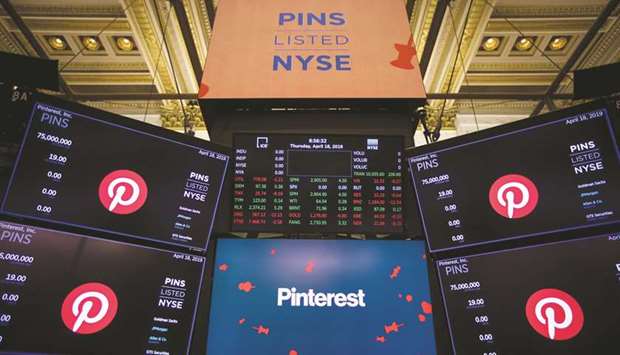Pinterest climbed as much as 33% in its trading debut after raising $1.4bn in the year’s second-biggest US initial public offering, pinning investor hopes on a continuing listing surge.
Shares of the digital-scrapbooking company opened at $23.75. They closed up 28% to $24.40 in New York trading on Thursday, giving the company a market value of about $12.9bn.
The listing is second in the US this year only to Lyft’s $2.34bn offering in March. Their IPOs will likely be eclipsed by Uber Technologies. The ride-hailing global behemoth will seek to raise about $10bn in May in an offering valuing it at about $100bn, people familiar with its plans have said.
Pinterest’s strong showing, along with an even stronger first-day performance by Zoom Video Communications on Thursday, signals continuing investor thirst for new stocks amid a surge of unicorns – startups valued at $1bn or more – coming to market. Zoom ended the day up 72% at $62 a share, causing its founder and chief executive officer, Eric Yuan, to fret over the sky-high price putting pressure on the company going forward.
Other high-profile companies considering going public include Slack Technologies, Postmates, Palantir Technologies and Airbnb.
“Today’s opening pop in the shares of Zoom and Pinterest suggests that investors are not looking at ‘risky’ unicorns as a group, but instead are valuing each company on their merits,” Alejandro Ortiz, principal analyst at SharesPost Inc, said in an e-mailed statement.
Fears that Lyft’s sagging stock – it’s fallen 19% from its $72 IPO price – would bode poorly for other unicorns appear to have been overblown, Ortiz said.
Pinterest sold 75mn shares on Wednesday for $19 each, after marketing them for $15 to $17. At the offer price, the IPO valued the San Francisco-based company at about $12.8bn, including restricted stock and options, according to data compiled by Bloomberg. Pinterest’s last valuation, from a private funding round in 2017, was $12.3bn.
The offering was led by Goldman Sachs Group Inc, JPMorgan Chase & Co and Allen & Co Pinterest trades on the New York Stock Exchange under the symbol PINS.
Pinterest operates in a crowded digital marketing space, where Google and Facebook get the lion’s share of ad dollars. Pinterest has taken a slow and steady approach to growth and making money from the service, compared with the faster expansion rates of Facebook, Twitter, and Snap when they went public.
“We’re really proud of the progress we made over the last few years,” chief executive officer Ben Silbermann said in an interview. “We built out the business. We felt like we were at a point where the business had reached a level of predictability that it could be in the public markets.”
Pinterest has a key advantage in competing for advertising dollars, Silbermann said. Unlike other sites, Pinterest users typically are looking to eventually buy what they are searching for, which lines up with what advertisers want, he said.
Losses Shrinking Pinterest said in its IPO filing that it reaches more than 250mn monthly active users. The company had about $756mn in revenue from online advertisements in 2018, a 60% growth rate that accelerated from the previous year. Its net loss shrunk to $63mn in 2018 from $130mn in 2017.
Most of its user growth is coming from international markets, where the average revenue per user is much lower than in the US In 2018, more than 80% of new users were from outside the US, however, they generated about 25 cents per person compared with $9.04 for those based in the US.
Silbermann said the company is just in the “first chapter” of its international growth and now has local sales teams in countries such as Canada, Germany and France.
Long-Term Focus “We’re going to continue to invest for the long term,” he said. “We’ve shown really good margin improvement over the last few years. My eye is always on what’s going to make Pinterest great three years, five years, 10 years from now. That’s going to be how we continue to run the business.”
Pinterest has done a great job of creating an ad business for the visual world, rather than a search that relies on keywords, said Eric Kim, a managing partner at Goodwater Capital.
“The question is whether Pinterest will be one of the primary digital advertising players – not just taking away market share from print but expanding the pie through their visual search,” Kim said.
Pinterest wasn’t as aggressive on its IPO pricing as it might have been, Kim said “I think they set it at a level that would give current investors upside in the future to get them excited about that,” he said. “It really comes down to that pricing call that Pinterest and their team decides where they want to start out at and track the right investors.”

Monitors display Pinterest signage during the company’s initial public offering on the floor of the New York Stock Exchange on Thursday. Pinterest climbed as much as 33% in its trading debut after raising $1.4bn in the year’s second-biggest US initial public offering, pinning investor hopes on a continuing listing surge.
